For the first time, the capital is hosting an exhibition entirely dedicated to the work of archaeologist-designer Francesco Corni (Modena, 1952 - Strambino, 2020). The exhibition project curated by Elisabetta Corni and Mirella Serlorenzi, promoted by the Special Superintendence of Rome, directed by Daniela Porro, and the Francesco Corni Foundation, will be on view from May 3 to Oct. 19, 2025 in the monumental spaces of the Baths of Caracalla.
The title of the exhibition, Imagining Rome. The Impossible Perspectives of Francesco Corni, recalls the artist’s visual approach, based on a detailed reconstruction of ancient Rome through unprecedented viewpoints, often technically unfeasible, but functional to a deeper understanding of places. The exhibition brings together sixty drawings, more than half of them previously unpublished, displayed in the two covered rooms of the Roman bath complex. Alongside the exhibition, the volume Roma, i luoghi del potere, published by Ink Line Edizioni, will be presented on May 2, collecting a large corpus of Corni’s drawings dedicated to the city. Andrea Carandini and Paolo Carafa, archaeologists and longtime scholars of Rome’s urban landscape, will speak, along with Mirella Serlorenzi , head of the Baths of Caracalla, Maria Cristina Ronc, director of the Archaeological Museum of Aosta, and Elisabetta Corni.
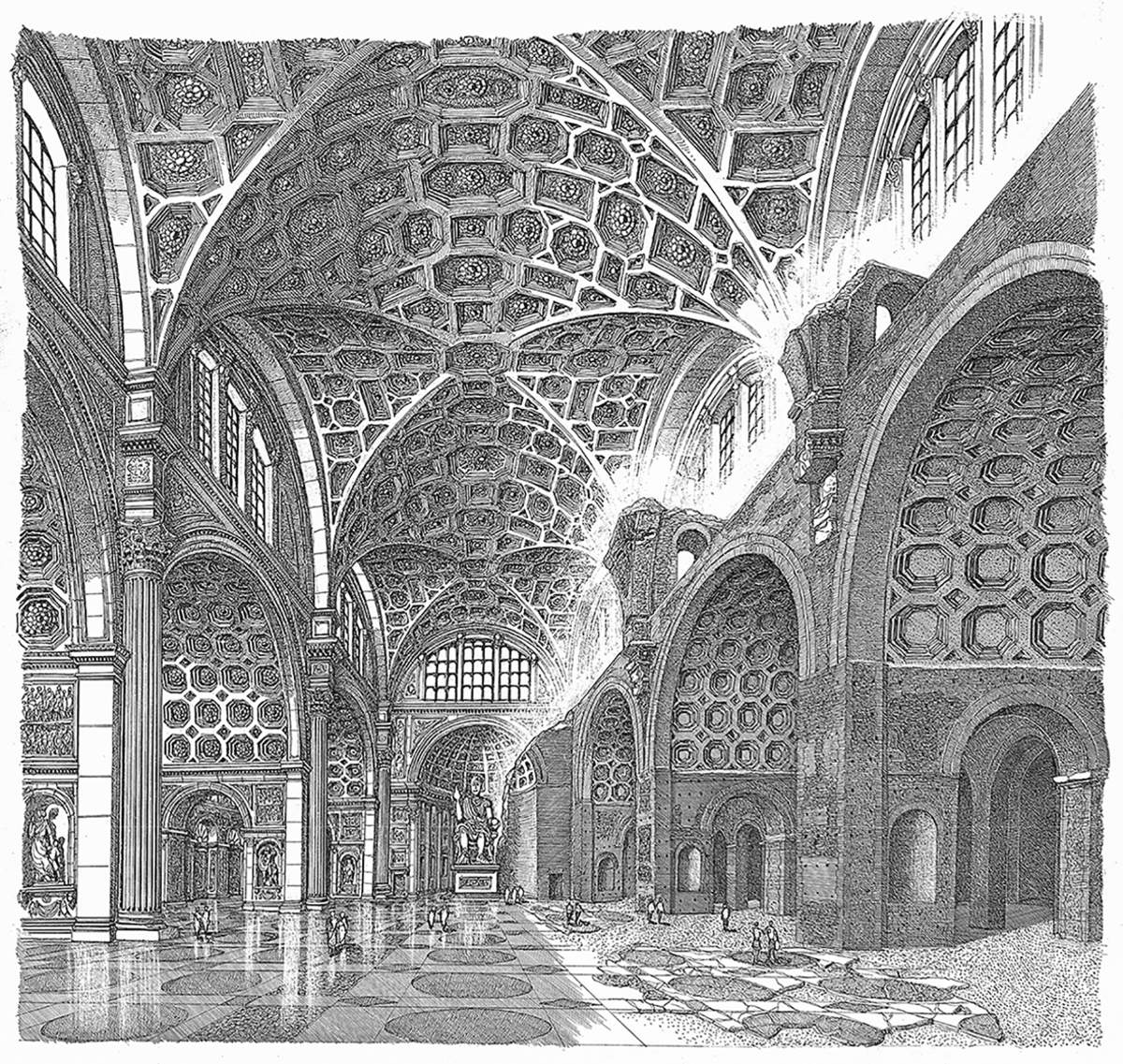
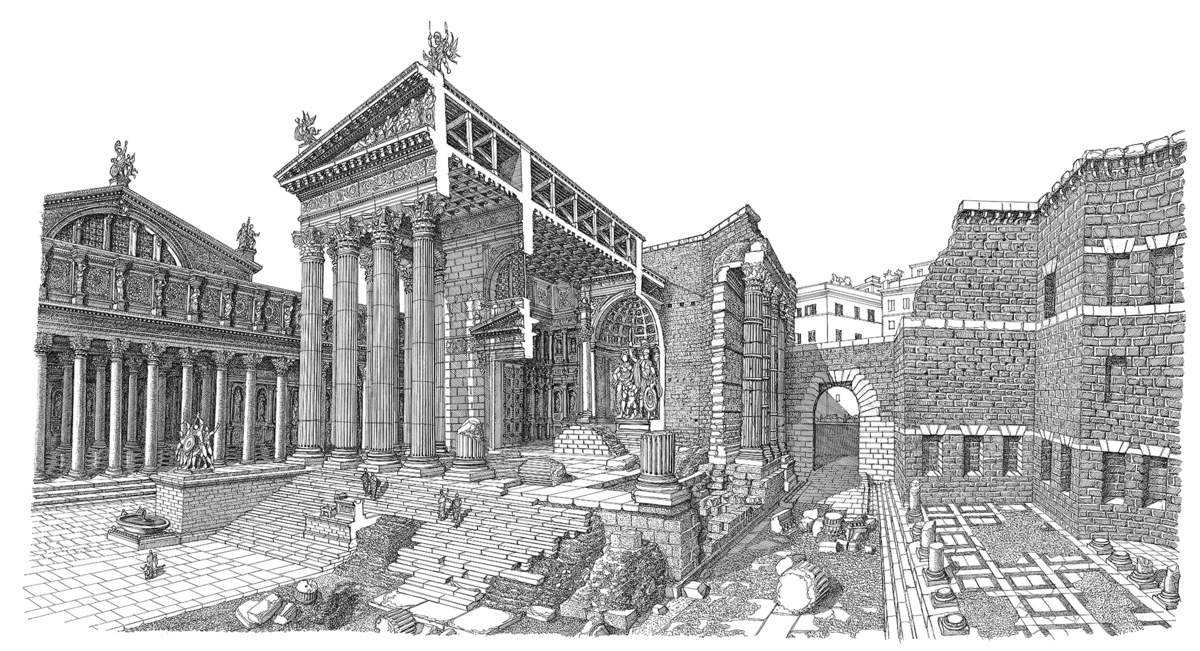
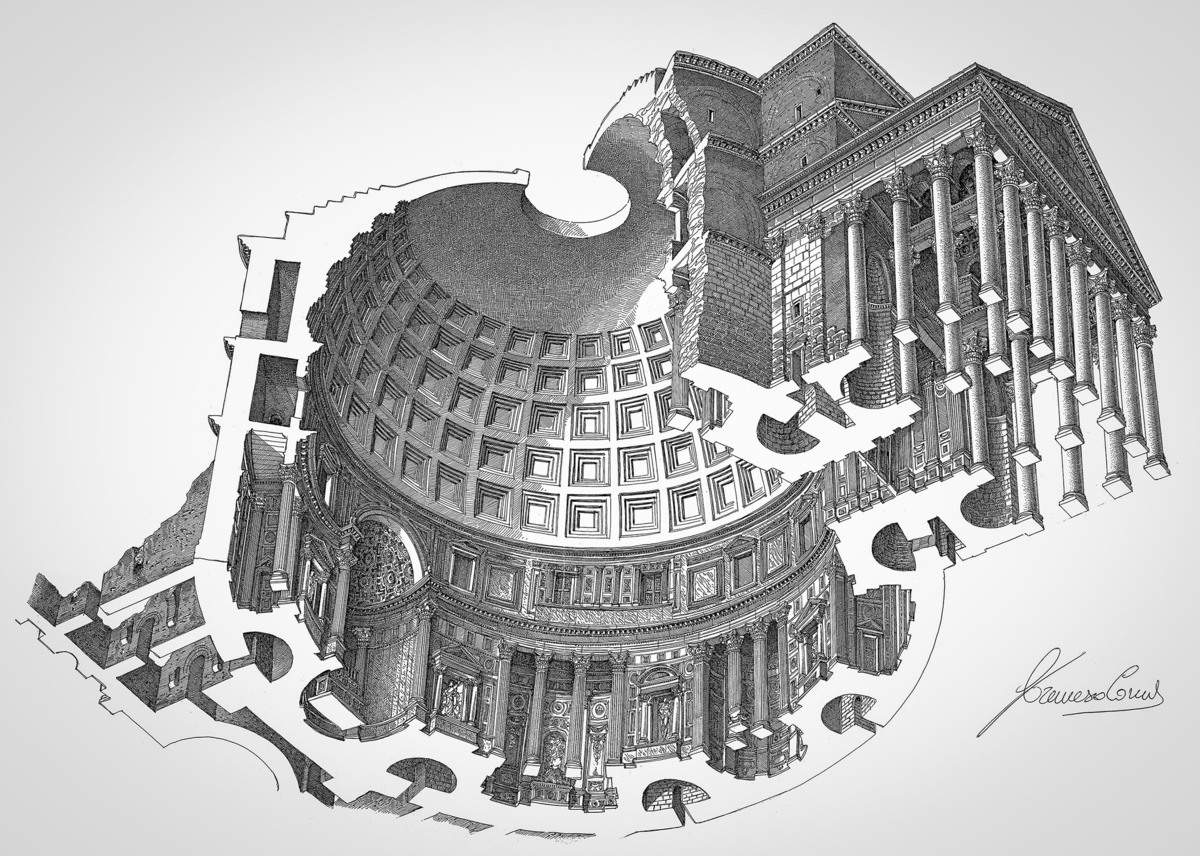
The exhibition is divided into two main sections. In the first room, in addition to a biography of the artist, the drawings illustrate an itinerary from the Capitol to the Forum Boarium, with a sequence of plates dedicated to such emblematic buildings as the Portico of Octavia, the Temples of Portunus and Hercules, and the Forum Holitorium. The precise stroke, balance of lines, and compositional structure recall the 18th-century engraving tradition, particularly the works of Giovanni Battista Piranesi. The plates offer a visual dialogue between present ruins and original layouts, highlighting the historical and urban stratification of the city. Emblematic in this regard is a vertical panel showing the present building fabric of the Rome Ghetto and, within it, the surviving columns of the Portico di Ottavia. This visual cutaway represents one of the impossible perspectives alluded to in the title of the exhibition, namely, a simultaneous point of view that unites different temporal and narrative planes. The theme of the dialogue between ancient and modern is further explored thanks to the presence, in the same room, of an archaeological map of the area created by SITAR (Sistema Informativo Territoriale Archeologico della Soprintendenza Speciale di Roma).
Closing the first section is a series of six drawings dedicated to the ancient Roman Forum, a place considered by Corni as the founding heart of the city. In this part the focus is on the original function of the urban space, analyzed in its monumental and political development.
The second room of the exhibition presents an articulation by thematic nuclei, delving into different aspects of ancient Rome. A first section is devoted to Roman engineering science and major urban construction sites, such as that of the Colosseum under construction. Another core is reserved for games, with representations of naumachiae and a reconstruction of Domitian’s Circus, on which Piazza Navona stands today. A further in-depth study concerns the baths: two drawings are devoted to the Diocletian complex, depicted both in its present form and at the height of its architectural splendor. Another group of plates concerns the Baths of Caracalla itself, among the last works Corni produced before his death. These are depictions that combine documentary rigor and aesthetic sense, with a strong focus on volumetric rendering and the distribution of space. This section also includes works selected for their compositional value. Corni often chooses unusual viewpoints, capable of revealing new perspectives on well-known monuments: the Pantheon, the Roman Forum and the Forum of Augustus, the Basilicas of Maxentius and Ulpia, and the Markets of Trajan. Some of these views summarize the evolution of individual buildings or urban areas, illustrating not only the architectural form but also the cultural and political function of the spaces.
The itinerary closes with a cycle of six drawings dedicated to the Vatican Hill, tracing the area’s transformations from the imperial age to the Baroque era. The plates start from the Horti of Agrippina and the Circus of Caligula, to the construction of the Constantinian basilica and finally to the urban and symbolic organization of papal Rome, with Bernini’s colonnade marking the definitive opening of the Church to the city. The Vatican cycle represents, also symbolically, the synthesis of Corni’s work: a visual narrative that spans the centuries while maintaining a constant focus on formal precision and documentary depth.
“The curators, Elisabetta Corni and Mirella Serlorenzi,” explains Daniela Porro, Special Superintendent of Rome, “have skillfully showcased the exceptional nature of Corni’s figure as a popularizer, which stems from a fabulous graphic talent combined with training as an archaeologist and the activity of draughtsman-detector in excavations in various locations in Italy and abroad. Very solid foundations that have enabled him to create plates that return not only the reconstruction of iconic buildings, but astonishing cutaways that reveal interiors and explain ancient construction techniques.”
“After the initiatives on contemporary art,” explains Mirella Serlorenzi, “we are presenting an exhibition dedicated to archaeology that finds a happy connection with the Antonine spa. Corni was a great illustrator and dedicated his final work to imagining the face of imperial Rome: among the last drawings stand out the Baths of Caracalla of which the artist was able to realize the state of affairs, but unfortunately not the reconstructive table due to his passing. The visitor will be the protagonist of this dream, immersing himself in the ancient monuments.”
“The greatest talent of this artist,” Elisabetta Corni argues, “is his ability of three-dimensional spatial vision; his mission, to explain reality. Even today, in the digital age, handmade drawing has a very strong communicative power, and Corni’s drawing is a dynamic synthesis of many elements that gives life to glimpses and perspectives that would not be possible to see otherwise.”
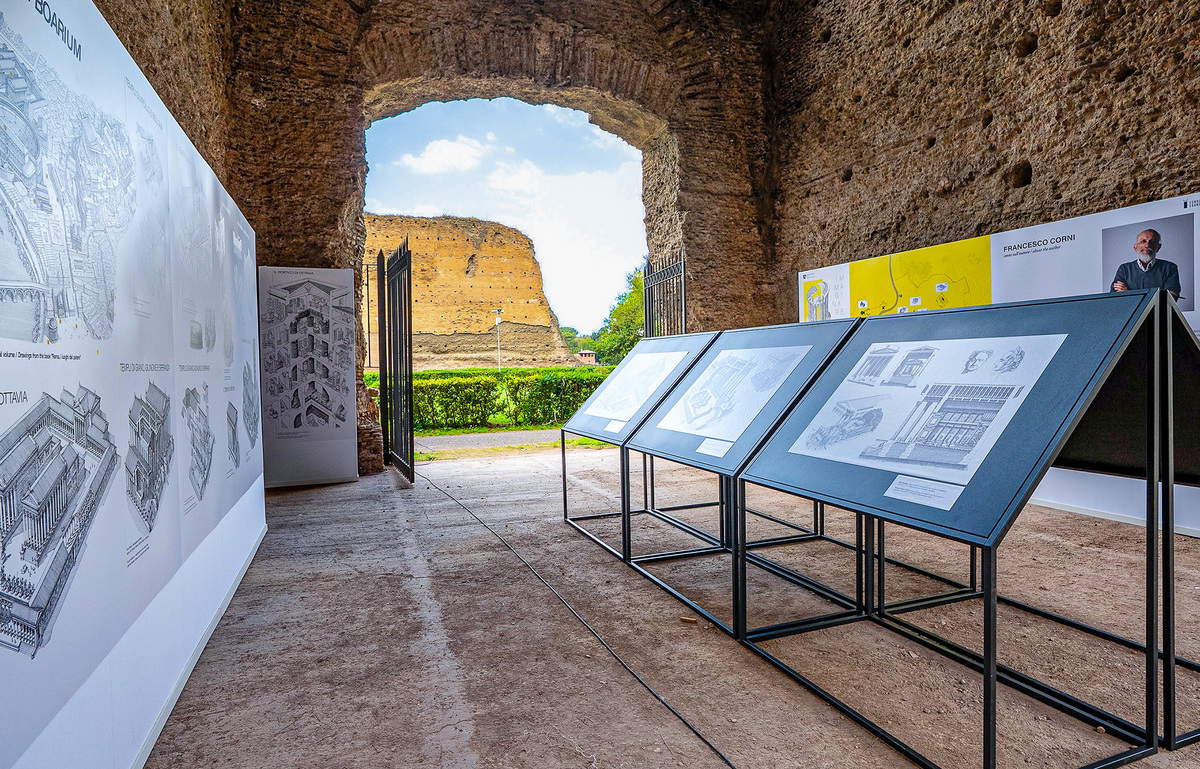
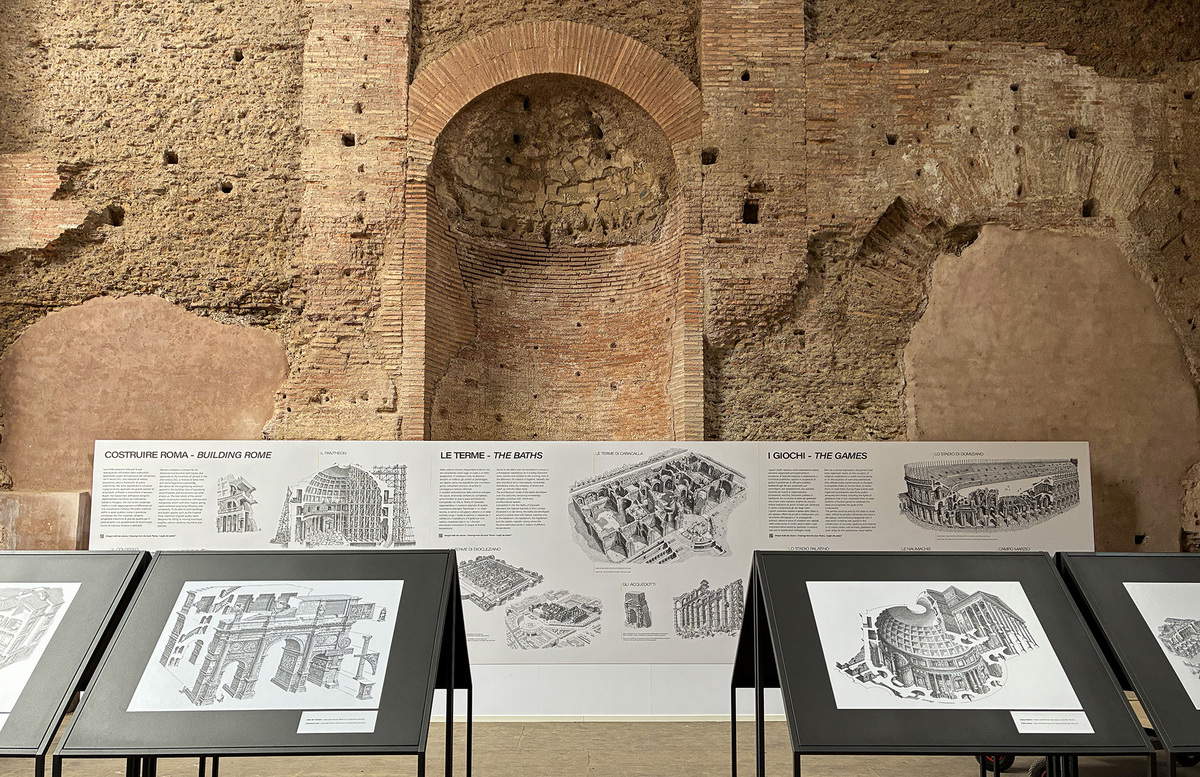
Francesco Corni, born in Modena in 1952 and raised in Turin, has made drawing the central tool of his historical and architectural popularization activities. His technical training was consolidated between Aosta and Switzerland, where he specialized as a surveyor in archaeological excavations. Since 1986 he has collaborated on a regular basis with the magazines Bell’Italia and Bell’Europa, contributing to the enhancement of Italian and European historical and landscape heritage. Drawing, a language that has accompanied him since childhood, is nourished by the visual suggestion of Gustave Doré’s nineteenth-century engravings and Giovanni Battista Piranesi’s eighteenth-century ones. Precisely during excavation activities, Corni identifies his own direction: to graphically restore the hypotheses of archaeologists, making them understandable even to the uninitiated. His works, created before the spread of digital reconstructions, offer a three-dimensional view of monuments and urban complexes, in a tradition that brings him closer to historical figures such as Alfredo d’Andrade and Eugène Viollet-le-Duc.
Central to his method is a distinct capacity for perspective vision, developed through years of study and application. Each subject is analyzed and broken down with the intention of finding the most effective angle to highlight its architectural peculiarities. Corni proceeds by selecting unusual viewpoints, opening sections, reconstructing elevations and employing perspective as a narrative tool. The technique used, strictly Indian ink, relies on the precision of Rapidographs with 0.1 and 0.2 millimeter tips. The meticulous stroke and level of detail present in each panel are not mere exercises in style, but visual signals that guide the audience’s gaze, inviting them to pause: what is depicted is worthy of attention.
 |
| At the Baths of Caracalla the first exhibition dedicated to an archaeologist designer: Francesco Corni |
Warning: the translation into English of the original Italian article was created using automatic tools. We undertake to review all articles, but we do not guarantee the total absence of inaccuracies in the translation due to the program. You can find the original by clicking on the ITA button. If you find any mistake,please contact us.